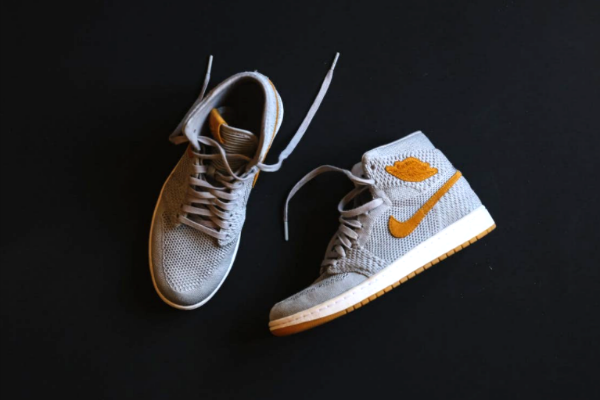 Basketball shoes have a history that parallels basketball itself. While basketball originated in 1891, basketball shoes were created in 1917. Since then, the industry has grown into a multibillion-dollar global industry.
Basketball shoes have a history that parallels basketball itself. While basketball originated in 1891, basketball shoes were created in 1917. Since then, the industry has grown into a multibillion-dollar global industry.
These shoes have become the most popular sportswear with good reason: they are versatile, trendy, and fashionable: it is not uncommon to wear basketball shoes off the field. With that in mind, let’s look at the history of basketball shoes and the NBA.
It Started With Converse
Converse was the first company to release a basketball shoe, the All Star shoe, in 1917. Shortly after, in 1920, the company made a deal with Chuck Taylor to use his name in their next release, the Chuck Taylor All-Star basketball shoe.
Taylor sold the shoes himself while teaching the fundamentals of basketball in high schools throughout the country. Although converse basketball shoes were first known as “Non-skids” due to their canvas upper and rubber sole, it did not take long before the sneakers were popularly known as the “Chuck Taylors” or “Chucks.”
Converse also released another version of the Chuck, “DR.J. Pro Leather,” in 1976. However, Tree Rollins was the last NDA player to wear the shoes on a basketball game during the 1979 and 1980 seasons. The shoes were replaced by leather and suede versions since they were a better fit for athletic purposes.
Nonetheless, Converse shoes became (and are still a popular) fashion choice and high-top sport sneakers. In the beginning, these shoes were only available in black and white. Converse only produced versatile colors towards the end of the decade.
The First Signature Shoe
Chuck might have been the first basketball player to have his name on a shoe, but Walt Clyde Frazier was the very first from the NBA to create their signature shoe design. This happened in 1973 when the company Puma offered Clyde his very own signature shoe, The Puma Clyde.
At the time, Clyde was playing for the New York Knicks. The Puma Clyde became the most popular basketball shoe of the 70s because it had a better design than the Chuck. The shoe had a suede upper, and it had a better stance due to its wider sole.
Decades later, more signature shoes have been designed using the image of basketball stars. For example, Shaquille O’Neal had his name on the Reebok the Shaq Attack which was hugely popular.
The choice of O’Neal by Reebok isn’t far-fetched as he is one of the greatest basketball players ever. It is in a similar vein that other players in other industries are lining up to be associated with the former Lakers star.
For example sports betting company, Betrivers successfully landed a partnership with him meaning that he will be the face of their products and offers including the NBA betting promotions which is one of many available to US bettors.
Nike’s Journey To The Famous Air Jordan Line
Nike followed Converse in 1972 and 1978 with two versions of basketball shoes: the Nike Bruin and The Blazer, respectively. Both pairs were made of leather, thus creating the Nike basketball shoe legacy.
Nonetheless, Nike later used low leather and suede to release newer versions of The Blazer and Nike Bruin. Even though Nike was becoming a famous brand in basketball in the 1980s, it wasn’t until its partnership with North Carolina’s skinny young ballplayer that the company was propelled by cash and popularity.
This player was the young Michael Jordan, who at the time played for the Chicago Bulls. Jordan’s collaboration with Nike introduced the Air Jordan basketball shoe in 1985 that became the signature shoe of the decade.
The Air Jordan was also the first shoe design to turn basketball shoes into a fashion statement. As a result, the Air Jordan line became the frontline for the basketball shoes. Jordan himself helped to market the shoes.
Since then, Nike has a history of integrating the most prominent basketball players into their marketing campaigns.
Basketball Shoes Construction History
Converse started its basketball shoe design using canvas upper and rubber sole. Puma then created a shoe design with a wider sole and a suede upper. Nike followed using leather, low leather, and suede. The shift in material happened because leather and suede were better choices for athletes.
Nike’s innovative shoe construction in the 80s inspired the use of high tech and science in the design and manufacturing of basketball shoes. The goal was to experiment with materials that offer more flexibility and support and give players an extra spring in their jumps.
Besides, the shoes also lasted longer because of the durability of the leather material. Basketball did shape sneaker history. But Nike has continued to be the driving force of innovation for NBA basketball shoes to this decade.
- Broadway’s Rising Stars Converge: A Day Of Inspiration At Broadway Express y Más
- Adams, Hochul And More Toast $5 Billion Housing Plan: Building Dreams Together!
- Alicia Graf Mack, Dancer, Educator, And Leader Appointed Artistic Director Of Ailey
- Update: More Illnesses Have Been linked To The McDonald’s E. Coli Outbreak
- Bronx: NYWF’s 30th Annual Dinner Honors Community Leadership And Purpose
Become a Harlem Insider!
By submitting this form, you are consenting to receive marketing emails from: . You can revoke your consent to receive emails at any time by using the SafeUnsubscribe® link, found at the bottom of every email. Emails are serviced by Constant Contact










how is it that the Air Jordan was made in 82, when Jordan only joined the league in 84 and Nike released the Air Jordans with Michael Jordan in the NBA . maybe you should double check your “facts”
Shaka,
Good catch. We corrected and updated the page (more to come).
Thank you
Kyle